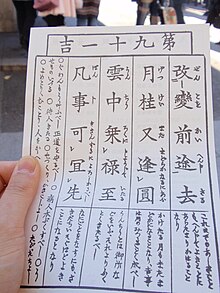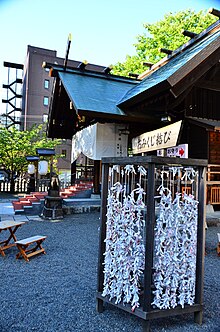| This article needs additional citations for verification. Please help improve this article by adding citations to reliable sources. Unsourced material may be challenged and removed. Find sources: "O-mikuji" – news · newspapers · books · scholar · JSTOR (June 2008) (Learn how and when to remove this message) |
 |
| Votive talismans designed for the home |
|---|
| Ofuda, and Jingū taima when from Ise Jingu |
| Votive paper slips applied to the gates of shrines |
| Senjafuda |
| Amulets sold at shrines for luck and protection |
| Omamori |
| Wooden plaques representing prayers and wishes |
| Ema |
| Paper fortunes received by making a small offering |
| O-mikuji |
| Stamps collected at shrines |
| Shuin |
Omikuji (御御籤/御神籤/おみくじ) are random fortunes written on strips of paper at Shinto shrines and Buddhist temples in Japan. Literally "sacred lot", these are usually received by making a small offering and randomly choosing one from a box, hoping for the resulting fortune to be good. As of 2024, vending machines sometimes dispense omikuji.
The omikuji predicts the person's chances of their hopes coming true, of finding a good match, or generally matters of health, fortune, life, etc. When the prediction is bad, it is a custom to fold up the strip of paper and attach it to a pine tree or a wall of metal wires alongside other bad fortunes in the temple or shrine grounds. A purported reason for this custom is a pun on the word for pine tree (松, matsu) and the verb 'to wait' (待つ, matsu), the idea being that the bad luck will wait by the tree rather than attach itself to the bearer. In the event of the fortune being good, the bearer has two options: they can also tie it to the tree or wires so that the fortune has a greater effect or they can keep it for luck. Omikuji are available at many shrines and temples, and remain one of the traditional activities related to shrine or temple-going.
A similar custom of writing a prayer on a specially-prepared wooden block called an ema, which is then tied to an ad hoc scaffold, also exists.
History

The omikuji sequence historically commonly used in Japanese Buddhist temples, consisting of one hundred prophetic five-character quatrains, is traditionally attributed to the Heian period Tendai monk Ryōgen (912–985), posthumously known as Jie Daishi (慈恵大師) or more popularly, Ganzan Daishi (元三大師), and is thus called Ganzan Daishi Hyakusen (元三大師百籤, lit. 'Ganzan Daishi's One Hundred Lots') or the Kannon Hyakusen (観音百籤, "Avalokiteśvara's One Hundred Lots"), after a legend claiming that these verses were revealed to him by the Bodhisattva Avalokiteśvara (Kannon).
Historically, however, the Japanese omikuji system is thought to have been modeled after the Chinese kau chim, a similar form of divination involving a tube full of bamboo sticks and a sequence of written or printed oracles. A wooden container containing oracular lots dated 1409 (Ōei 16) is preserved in Tendai-ji in Iwate Prefecture, suggesting that this method of fortune telling was imported to Japan somewhere before the Muromachi period (1336–1573). The quatrains of the Ganzan Daishi Hyakusen are themselves ultimately based on a set of oracles dating from the Southern Song period (1127-1279) known as the Tiānzhú língqiān (天竺靈籤, lit. 'Indian Numinous Lot'; Japanese: Tenjiku reisen).
The Ganzan Daishi Hyakusen became popular in the Edo period due to the notable monk Tenkai (1536–1643), who is credited with attaching Ryōgen's name to it. A story related by one of Tenkai's disciples claims that Tenkai was once visited in a dream by Ryōgen, who revealed to him the existence of the 100 quatrains, which had been supposedly lost for centuries. Copies of these short poems were eventually discovered at Togakushi Shrine in Shinano Province (modern Nagano Prefecture) and widely disseminated. The Ganzan Daishi Hyakusen eventually became standard across many Buddhist temples (even those not affiliated with the Tendai school) and served as a model for other omikuji sequences. Various books explaining the meaning of the oracles were published during the period, suggesting their widespread popularity.
Fortunes

The standard Ganzan Daishi Hyakusen sequence contains the following fortunes (from best to worst):
- Great blessing (大吉, dai-kichi)
- Blessing (吉, kichi)
- Small blessing (小吉, shō-kichi)
- Half-blessing (半吉, han-kichi)
- Future blessing (末吉, sue-kichi)
- Future small blessing (末小吉, sue-shō-kichi)
- Misfortune (凶, kyō)
Other sequences may include additional degrees such as "middle blessing" (中吉, chū-kichi), "great misfortune" (大凶, dai-kyō), or "blessing misfortune still undetermined" (吉凶未分, kikkyō imada wakarazu, i.e. one's fortune could end up being either good or bad depending on one's actions).
It then lists fortunes regarding specific aspects of one's life, which may include any number of the following among other possible combinations:
- hōgaku (方角) – auspicious/inauspicious directions (see feng shui)
- negaigoto (願事) – one's wish or desire
- machibito (待人) – a person being waited for
- usemono (失せ物) – lost article(s)
- tabidachi (旅立ち) – travel
- akinai (商い) – business dealings
- gakumon (学問) – studies or learning
- sōba (相場) – market speculation
- arasoigoto (争事) – disputes
- ren'ai (恋愛) – romantic relationships
- tenkyo (転居) – moving or changing residence
- shussan (出産) – childbirth, delivery
- byōki (病気) – illness
- endan (縁談) – marriage proposal or engagement
Relation to fortune cookies
The random fortunes in fortune cookies may be derived from omikuji; this is claimed by Seiichi Kito of Fugetsu-Do, and supported by evidence that American fortune cookies derive from 19th century Kyoto crackers called tsujiura senbei.
Gallery
-
 Young people in Osaka comparing omikuji on New Year's Eve
Young people in Osaka comparing omikuji on New Year's Eve
-
 Tying omikuji at Kasuga Shrine in Nara
Tying omikuji at Kasuga Shrine in Nara
-
 An omikuji vending machine at Tsurugaoka Hachiman-gū
An omikuji vending machine at Tsurugaoka Hachiman-gū
-
Pocket omikuji
-
Decorative pocket omikuji
-
 Omikuji ritual at Omuro Sengen Shrine, Fujiyoshida, Yamanashi
Omikuji ritual at Omuro Sengen Shrine, Fujiyoshida, Yamanashi
-
 Children drawing omikuji fortune sticks from a metal cylinder at Asakusa Temple (Sensoji) in Tokyo, Japan.
Children drawing omikuji fortune sticks from a metal cylinder at Asakusa Temple (Sensoji) in Tokyo, Japan.
-
 A bad omikuji fortune (凶, upper right) drawn at the Toyokawa Inari branch temple in Tokyo, Japan.
A bad omikuji fortune (凶, upper right) drawn at the Toyokawa Inari branch temple in Tokyo, Japan.
See also
- Futomani
- I Ching divination
- Itako
- Kokkuri
- Kau chim
- Jiaobei
- Omamori
- Onmyōdō
- Poe divination
- Tengenjutsu
References
- Basic Terms of Shinto, Kokugakuin University, Institute for Japanese Culture and Classics, Tokyo 1984
- "「おみくじ発祥の地」が比叡山延暦寺に! 1,000年以上前の形式を今なお残す". 伝教大師最澄1200年魅力交流 コミュニケーションサイト「いろり」 (in Japanese). Retrieved 2021-11-21.
- ^ "おみくじの起源". 妙法寺(蕪村寺)(Myōhō-ji (Busondera) Official Website). Retrieved 2021-11-21.
- Strickmann, Michel; Faure, Bernard (2005). Chinese Poetry and Prophecy: The Written Oracle in East Asia. Stanford University Press. ISBN 9780804743341.
- "観音籤及び筒". いわての文化情報大事典 (Glossary of Iwate's Cultural Information). Retrieved 2021-11-21.
- ^ Maruyama, Shūichi. "おみくじ" (PDF). 仮説実験授業研究会・北海道. Retrieved 2021-11-21.
- Hidaka, Iku (2020). "南宋版『天竺霊籤』原本再現の試み ─後補図75番を例として─". Journal of the Society of Art and Design. 1. doi:10.34524/jsartdesign.1.0_3.
- Ōno, Izuru (2001-09-30). "おみくじと天道―元三大師御銭注解考―" (PDF). 日本思想史学 (Journal of Japanese Intellectual History). 33: 130.
- Ōta, Masahiro (November 2018). "「おみくじ」の起源と諸相". 明治聖徳記念学会紀要 (Transactions of the Meiji Seitoku Kinen Gakkai). 55: 69–71.
- A History of Fugetsu-Do, www.fugetsu-do.com
- Lee, Jennifer 8. (January 16, 2008). "Solving a Riddle Wrapped in a Mystery Inside a Cookie" "feb 24 2004 how to see your fortune the fortune cookie" The New York Times. Retrieved on January 16, 2008.
External links
| Shinto shrines | |||||||||||||||||||||||||||||
|---|---|---|---|---|---|---|---|---|---|---|---|---|---|---|---|---|---|---|---|---|---|---|---|---|---|---|---|---|---|
| |||||||||||||||||||||||||||||
| |||||||||||||||||||||||||||||